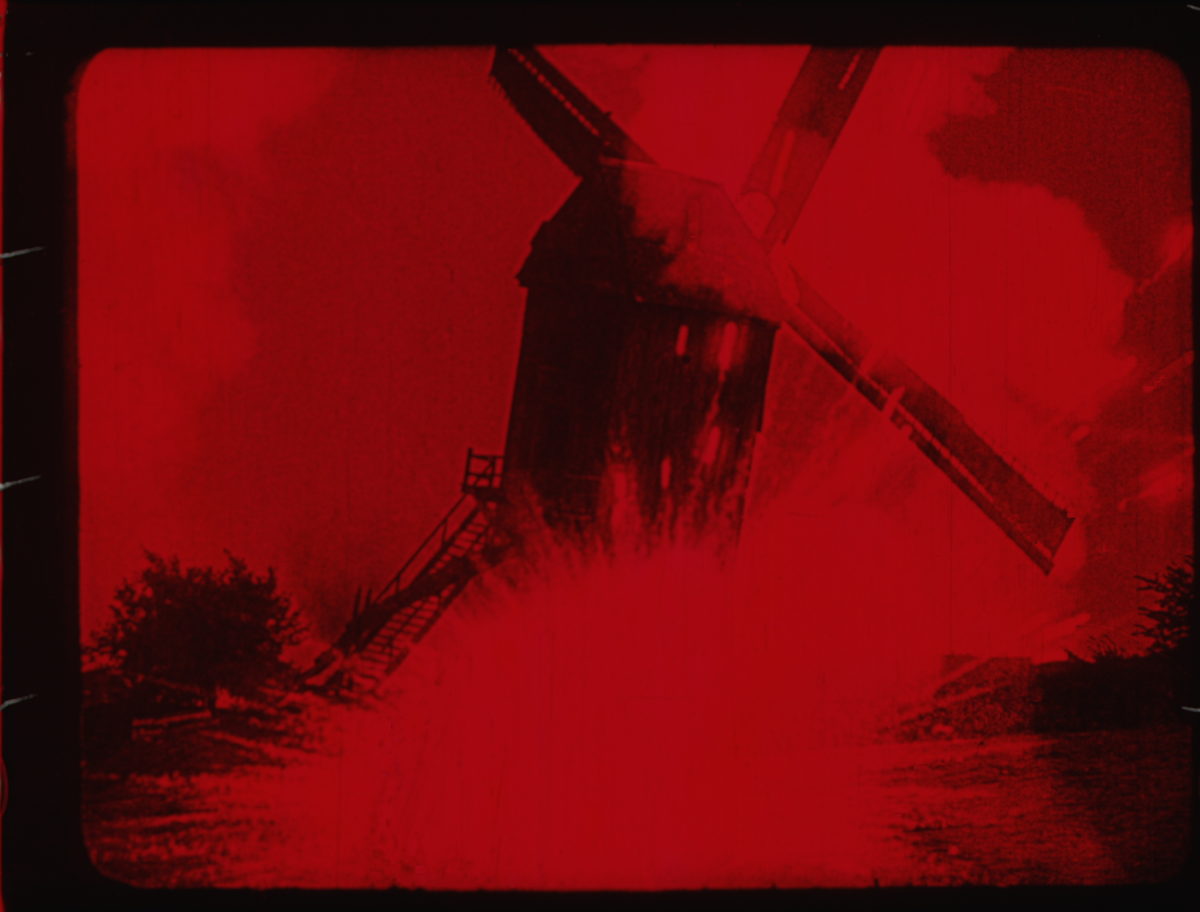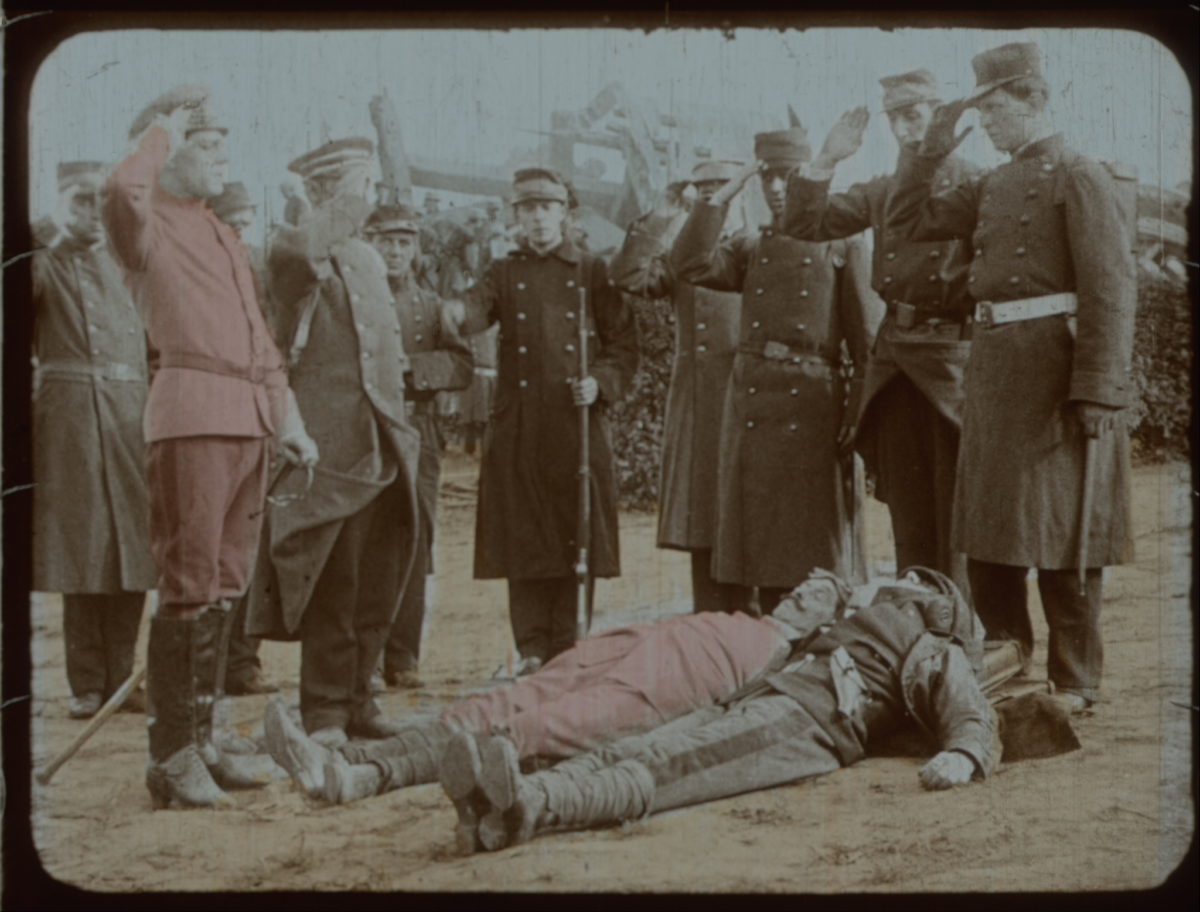After a series of adventures in Africa making hunting pictures (with straightforward titles such as Chasse à la panthère or Chasse a l’hippopotame sur le Nil bleu) and exotic documentary scenics, Alfred Machin (1877-1929) left France for new uncharted territories: Brussels, Belgium. Here, he became artistic director for Belge Cinéma, one of Pathé’s foreign studios, and was commissioned to boost film production in Belgium and the Netherlands. Two of the numerous films he made in Belgium (in his studio in Brussels and on location) were screened in Bologna at the Cinema Ritrovato, both with excellent musical accompaniment. Stephen Horne played the piano, the flute and a harmonica (all by himself and often simultaneously) for La Fille de Delft, and Gabriel Thibaudeau provided subtle piano accompaniment for Maudite soit la guerre at the Piazza Maggiore under a blazing sky.
La Fille de Delft (1914) is a simple tale of childhood love and the cruel twists of fate. It’s the story of miller’s daughter Kate, who spends her time picking and selling tulips and enjoying innocent kisses with her childhood sweetheart, Jefke. Her innocence and youthful sense of joy find expression in her uninhibited and cheerful dancing at a local fair – a quaint little kermesse. When her father dies unexpectedly when his windmill is destroyed in a thunderstorm, her fortunes change. Kate is sent to the city to be trained as a dancer and so that which was once a manifestation of her love of life becomes stained with the fake magnificence and sexual corruption of professional entertainment in the big city. Attempts by Jef to get his sweetheart to come back home are to no avail, as Kate has become enamored with her faster life, blinded by the city’s many attractions. The tables are turned again when Kate, all grown-up now and courted by eager gentlemen with shady intentions, is injured in a spectacular balloon crash. Kate is blinded for life and, fittingly, her affliction makes her see that her life in the city was based on lies and false friendships, whereas true love and friendship are still waiting for her in her native rural home. (Luckily her childhood sweetheart, a shepherd, is by profession a very patient man.)
This type of melodramatic love story was of course well-worn even by 1914 standards, but Machin manages to make it worthwhile and even quite touching through his controlled compositions of rural Dutch (actually Belgian) landscapes and relaxed staging practices. Surely there are also some very impressive and spectacular images to be found here (aerial views, a balloon crash, a thunderstorm, a fire), but most of the time we are invited to observe the characters walking through finely framed landscapes, past diagonal rows of tulips, past the sturdiness of the in hindsight often sinister, or cursed windmills. There are framings through windows and doorways, and characters are placed in detailed sets that allow simultaneous foreground and background action. Movements are deliberate but not rushed; we get the rhythm of life, not of dramatic development.
In Machin’s images there is always a lot to look at, as small figures can be observed moving about in the image’s distant depths. Cineteca curator Mariann Lewinsky referred to Machin’s trust in his audience’s “aesthetic patience”, a phrasing that I liked because there is indeed a palpable sense of the director’s faith in the subtlety of the detailed image that would please viewers. As such the rhythm between shots and within the image is comfortably slow, we can follow the story and take in its world and it never gets dull.

Of the dozens of films that Machin shot in Belgium, the majority feature that clichéd, if distinctive and effective, motif of the windmill. Windmills serve pictorial and narrative purposes in Machin’s films: they regionalize and localize the imagery, rooting it clearly in a rural and typically Belgian or Dutch environment (they recall landscape painting by Turner, Van Gogh, Stanfield) but they are also used as dramatic arenas. In Machin’s Le moulin maudit (1909), for instance, a jealous miller ties his romantic rival to one of the windmill’s blades. In L’âme des moulins (1912), a tramp cruelly trashes a little boy’s toy windmill after the miller has refused him money. At night he sets fire to the windmill and as the flames consume the impressive construction, its destruction is reflected in a small creek. In 1913’s Maudite soit la guerre the windmill serves as the foreign soldier’s final hideout from which he kills his own former best friend. Machin must have found the silhouette of the windmill placed dramatically against the skies pictorially quite powerful, as he used it in so many of his films.
Equally resonant is Machin’s use of superimposition effects, conjuring up the spirits of the dead. This trick was already quite popular in silent cinema, but it really came to the fore in the years just after the War when animism and spiritualism pervaded popular thought and both literary and film narratives. Typical of Machin, the effect is rendered with an immediacy of feeling that makes it use much more poignant than in the more allegorical films, like Ince’s Civilization (1916), in which its function is much more mystical and aesthetic.
Much like La Fille de Delft, Maudite soit la guerre (1913) relies on melodramatic structures. It is the familiar tale of friends (or alternatively brothers, or lovers) separated by the destructive forces of nationalism, ideology and religion. Much like the narrative of D.W. Griffith’s Birth of a Nation (1914), but rather more concise, Maudite soit la guerre focuses on respectable families on either side of a (budding) military conflict. Adolph Hardeff visits his supposedly (the countries are fictional and never named) Belgian friends, the Modzels and stays on for his military education. Soon, Hardeff forms a tight friendship with Sigismond Modzel, the family’s son, and finds love with the Lidia Modzel, the sweet daughter. When war is declared, the former best friends are obligated to fight against each other in an anonymous war. They end up fighting each other in a windmill. They both die.
And so as usual, it’s left to the widowed or bereaved women to murmur the film’s forceful title.

Maudite soit la guerre (1914) was restored by CINEMATEK and EYE Institute. The collaboration resulted in a stunning recreation of the original color scheme of the film. The film was screened in open-air at the Piazza Maggiore against a dark, thunderous sky, a fitting viewing context. The extensively stencil-colored film uses color for subtle dramatic purposes and keeps our attention fixed on small narrative and emotional detail and the ironies of fate. Other than that, the colors of the uniforms (brown), of the geraniums in the heroine’s garden and of the heroine’s dress catch our attention and punctuate dramatic high points. The use of reds during the spectacular areal sequences with balloons being bombed and consumed by an apocalyptic fire, were breathtaking.
For me, these details of color amidst grey and black and white images made the image appear paradoxically more “unreal”(of another time as well as a part of a clearly constructed, created reality) than in a monochromatic print. The colors are so beautiful and dominant that they recall not just their original laborious creation but also the work of the restoration. A next viewing should restore the focus on the touching heart of the story and the elegant staging.